Samsung Galaxy Note 10+ Review
- Paul Thurrott
- Sep 24, 2019
-
27

The Samsung Galaxy Note 10+ is one of the very best smartphone flagships of 2019, with high-end specifications, an excellent design, and some truly unique features. Despite this, recommending the Note 10+ is complicated by a surprisingly long list of problems, from its lackluster in-display fingerprint reader to some gimmicky software features to its lack of a headphone jack. And the camera system, while excellent, is no match for the past few years of Huawei and Google flagships. (And probably for the iPhone 11 Pro family, which I’ve not yet tested.)
Design
As you may recall, my initial Note 10 purchase was a non-Plus device in a trippy Aura Glow that reflected back an animated rainbow of colors as you moved it around in your hand. That handset was fantastic, but I immediately realized that I wanted the larger Note 10+, and by the time I purchased the replacement, Aura Glow was no longer available. (It is now.) So I purchased an Aura Blue version instead. It’s not as unique and impressive looking as Aura Glow, but it is stunning in its own way, with a deep, saturated blue color. I especially like that this color extends to the aluminum top and bottom of the device, where the Aura Glow version was plain silver. It’s a very attractive handset.
Windows Intelligence In Your Inbox
Sign up for our new free newsletter to get three time-saving tips each Friday — and get free copies of Paul Thurrott's Windows 11 and Windows 10 Field Guides (normally $9.99) as a special welcome gift!
"*" indicates required fields
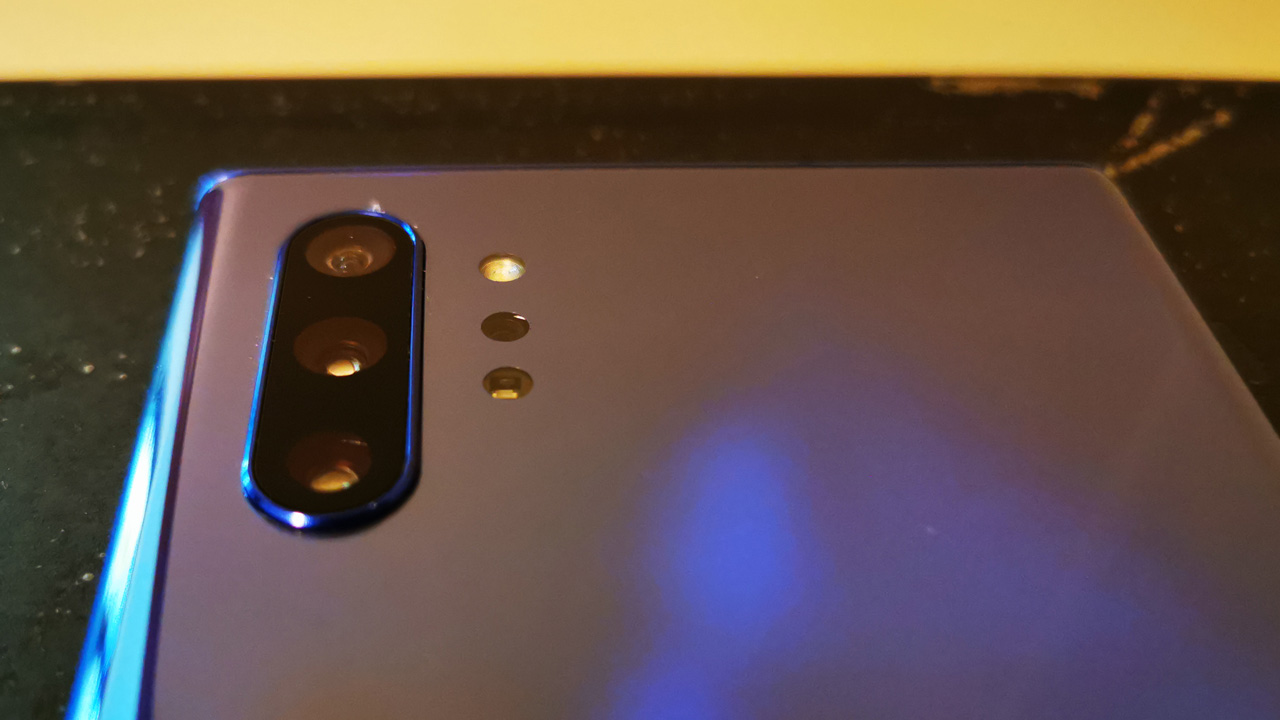
It will also need to be covered in a case, thanks to its glossy and fingerprint-revealing back and its fragile glass exterior. I got a free Samsung leather case with my online purchase—those who order from Samsung.com get up to $200 of credit towards accessories and other Samsung goods—and it’s as nice as anything that Apple makes for iPhone. And the device’s blue color still peeks through at the bottom, which is mostly open.

Compared to the similar Galaxy S10+, which is a bit bulbous and curved, the Note 10+ (like the smaller Note 10) has a straight-edged, wedge-like design that I very much prefer. That said, it may be a bit too masculine for some, and the very large size accentuates that. The rear camera lenses are stacked vertically in the upper left corner of the rear of the handset, much like last year’s iPhone XS, rather than horizontally in the center back as before. I happen to prefer the new layout, but it’s not something I see regularly, so it almost doesn’t matter.
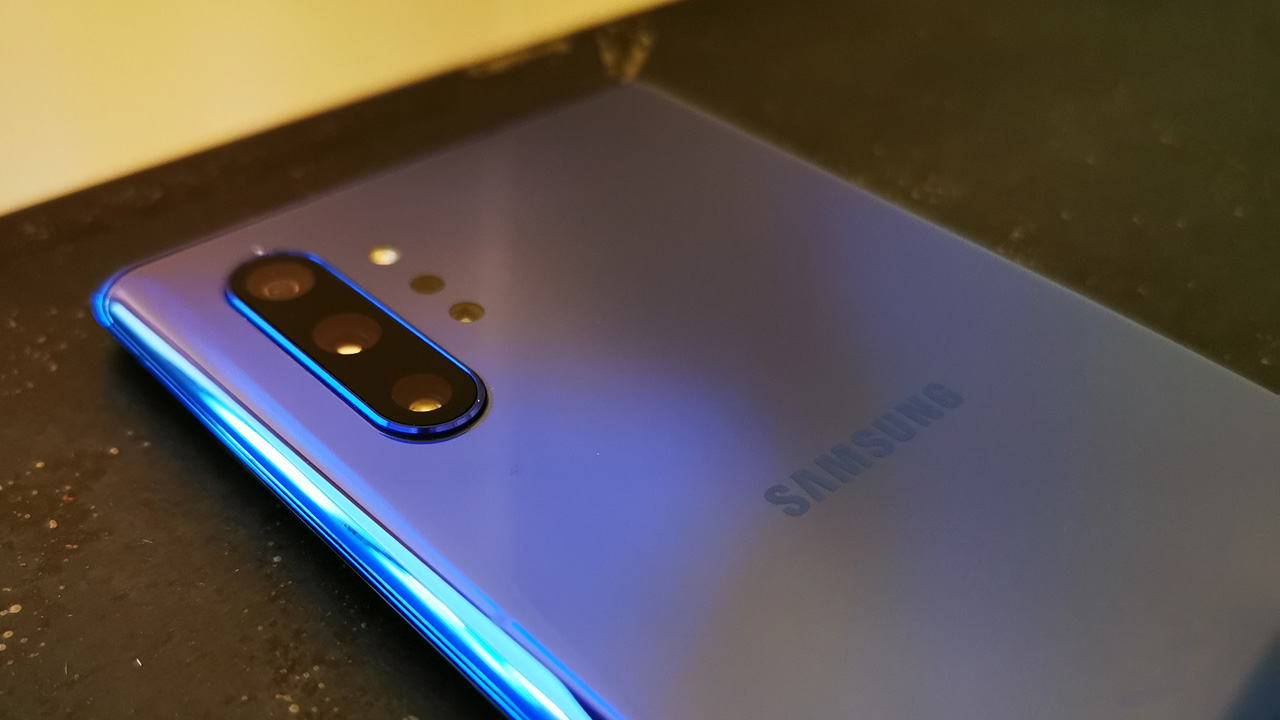
Of course, the primary selling point of this handset is its enormous, all-display design. So let’s move right to that.
Display
With the Note 10+, you come for the display … and you probably stay for the display, too. It’s a gorgeous and bright AMOLED panel, with deep, inky blacks and … oh, who cares? The damn thing extends past the edges of the device on the right and left, thanks to Samsung’s now familiar curved edge design, and it extends nearly to the top and bottom, too, creating what is today the most bezel-free device design on earth. Combined with the sheer scale of the display, which measures 6.8-inches from corner to corner, the effect is mesmerizing. And while it doesn’t offer the 90 Hz refresh rate of the OnePlus 7 Pro’s display—which is made by Samsung, ironically—it is still the best display I’ve ever tested.
Part of the allure, go figure, is that Samsung utilizes a small, circular “hole punch” cutout for the front-facing camera rather than a notch or the larger corner-mounted ovoid cutout that it used on the Galaxy 10S. No interruption would be better, for sure—and here, the OnePlus 7 Pro, with its unique pop-up selfie camera, does come out ahead, aesthetically. But the Note 10+ just looks neat, in part because of that cutout. It only really becomes problematic while playing video, for the most part, and even that is just a minor concern.

If there’s one valid criticism of this display, at least theoretically, it’s that it offers “only” 1440p of resolution (it measures 3040 x 1440 pixels, or nearly 500 ppi) in an age in which any true flagship should provide 4K/UHD. On paper, that’s fair, but in use, the Galaxy Note 10+ doesn’t suffer from this lower maximum resolution, and I’ve been using it on its default FHD+ (2280 x 1080) resolution, in part because it looks so great and in part because it helps with battery life.
The qualities that make this display so great are many, but with nearly 700 nits of brightness, well above any of the competition, HDR10+, and several useful software features, like adaptive brightness, a blue light filter, night mode, and an optional vivid screen mode with advanced white balance customization, it’s unlikely that anyone would take issue with its quality. Whether you’re reading, playing games, or watching video, this is perhaps the single best smartphone display in the market today.
Hardware and specs
In the United States, the Galaxy Note 10+ is powered by the Qualcomm Snapdragon 855 processor, while customers elsewhere in the world get Samsung’s comparable Exynos 9825 chipset. Both are high-end, leading-edge designs. But as most tech enthusiasts know, OnePlus is about to ship a new handset based on the new and even more powerful Snapdragon 855+, and it’s fair to wonder why Samsung didn’t utilize this superior chip as well. After all, the point of the 855+ is to provide an interim solution to handset makers midway between Qualcomm’s annual flagship chipset releases.
That said, no one will ever experience any performance issues with the Note 10+, which is further aided by 12 GB of RAM and 256 GB or 512 GB of storage, with expansion to another 1 TB via microSD. That storage is the best in the market: It’s UFS 3.0, as on the OnePlus 7 Pro, but because Samsung utilizes the new F2FS file system instead of EXT4, it’s even faster. Overall, the Note 10+ is a beast, and, like the OnePlus 7 Pro, is essentially the equivalent of a gaming PC in your pocket.
Also helping matters, the 4300 mAh battery is humongous and helps the Note 10+ achieve better than all-day battery life: I’ve never come close to running out of juice, even during long days of photographing Washington D.C. on a recent long weekend trip. The Note 10+ also supports “super-fast charging” up to 45-watts, though Samsung only includes a 25-watt charger, for “fast charging,” in the box. Still, it’s better than what most modern smartphones include.
Cameras
The Galaxy Note 10+ provides a four-lens rear camera system that includes a dual aperture 12 megapixel (MP) wide-angle primary lens with f/1.5 and f/2.4 modes, a 12 MP telephoto lens with a f/2.1 aperture, and a 16 MP ultrawide lens with a f/2.2 aperture, and a time-of-flight (TOF) 3D VGA lens that jumps in automatically to help with edge detection and depth control in portrait mode shots and videos. The wide-angle primary lens and ultra-wide lens both support optical image stabilization (OIS), and the system provides a total range of 2.5x optical zoom—using Apple’s new measurement type—with 0.5x on the ultra-wide in one direction and 2x optical zoom on the telephoto.

If you own a Galaxy S10+, this will all look familiar: Only the TOF lens is new to the Note 10+. (Conversely, the Note 10+ selfie camera lacks the 8 MP RGB depth lens found on the S10+, a victim of its smaller punch hole cutout.) And that could be problematic if you’re looking for the very best in camera quality, given that the S10+ is handily outperformed by three and a half generations of Google Pixel handsets and about two years’ worth of Huawei flagships.
Well, I’ve got good news and bad news.
Let’s start with the bad news: Yes, the Note 10+ camera system is also outperformed, overall, by all Pixels and the past two years’ of Huawei handsets. Nothing has really changed there.

The good news? The Note 10+ camera system is excellent, and it has surprised me over 600 or so shots with some truly stunning photos. It doesn’t always deliver—even a gimme like shots taken on a clear, sunny day can be washed out—and food bloggers, in particular, will want to stick with Huawei. But I could live with this camera. And I can recommend it to others.
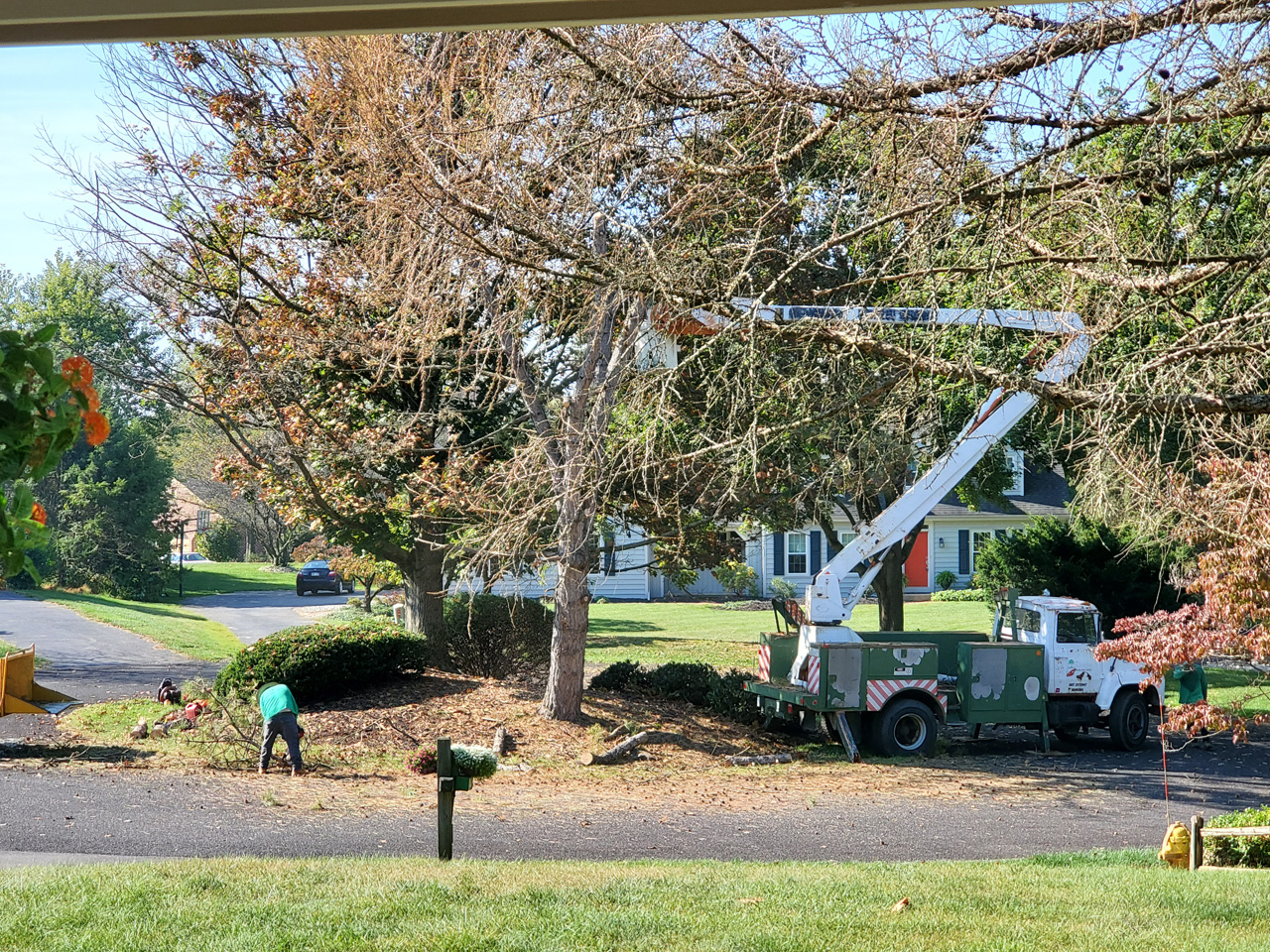
It helps not to do side-by-side shots with the best smartphone camera systems. On that recent long weekend trip to D.C., I resolved to use the Note 10+, and only the Note 10+, for photos. And I was really pleased with the results. But we had visited D.C. back in June, too. And on that trip, I took most of the photos with a Huawei P30 Pro, and those photos blow the Samsung entries out of the water. They’re just not comparable.

In my experience, the Note 10+ will usually deliver the types of snapshots I’m looking for, and I suspect that most people would be quite happy with the results. But I have found myself needing to bump up the contrast a bit, manually, to achieve the effect I want. Fortunately, Samsung provides a brightness slide on-screen for this very purpose. So it’s an extra step, yes, but it’s right there.

Also right there, on-screen while taking photos, are useful controls for switching between the three main lenses (wide, ultra-wide, and telephoto) and for toggling the built-in scene optimizer, which identifies objects in the viewfinder and adjusts the picture accordingly. It can sense things like food, of course, and it will offer to use a Bixby feature to pull the text out of images that include signs or other areas with text.

The camera app also provides an incredible—perhaps too incredible—list of capture modes that should satisfy any need. There is a basic Photo Video mode, of course, but also Live Focus, which can add blur effects on the background, a Pro mode for those who really know what they’re doing, Panorama, a surprisingly good Night mode, and silly Food and Instagram modes. For video, there’s a standard Video mode, plus Live focus video, Super Slow-mo, and Slow motion.

I don’t do a lot with video, but then I don’t do a lot with photos, either: I usually just point and shoot. This works well with those Google and Huawei handsets, and it mostly works well with the Note 10+. Other than those times where the image looks washed out and I need to adjust the brightness.

Security
With the Note 10 lineup, Samsung has moved past its rear-mounted fingerprint readers, which worked very well despite being routinely positioned too close to the rear cameras, and has added an in-display fingerprint reader in its place. It doesn’t work very well: It’s slow to register presses, and routinely tells me I need to press harder as I frustratingly miss a photo moment because it won’t unlock the damn phone. I’ve tried every trick I’ve seen to fix this, from removing the bundled screen protector to registering the same fingers multiple times, but it just doesn’t work very well. It took OnePlus two generations to get this kind of solution to the right place, and I suspect Samsung will need at least this long. The fingerprint reader is one of this phone’s worst features.
Samsung does provide alternatives, of course: In addition to just using a PIN, which I find myself doing routinely to bypass the fingerprint reader, you can enable Face recognition, which Samsung says is “convenient” but “less secure” and less reliable, too, since changes to your appearance might fool it. I feel that only Microsoft (Windows Hello) and Apple (Face ID) have created facial recognition that is both secure and performant, and I never enable this functionality on any Android device.
Unique hardware features
For the Note 10 family, Samsung removed the dedicated Bixby button, reducing the number of physical buttons from four to three. It also moved all of them to the left side of the device. This is confusing at first, but like all things you do regularly, you get used to it. (To access Bixby, just hold down on the Power button. Don’t use Bixby? You can configure the long-press to do something different.)
But the real star here, of course, is the S Pen. I like that the S Pen is available and that it can be tucked away in its garage when not in use, ensuring that you won’t lose it. But because it has to fit in the device, the S Pen is necessarily small, and it is too small for me to use comfortably with my very large hands.

That won’t be an issue for many, of course, and when you pop S Pen out of its garage with device’s display asleep, it goes immediately into a handy “off screen” note-taking and drawing mode, which can be useful when you’re out in the world and want to remember something. These inkings can be saved to Samsung Notes with a tap. (And you can, of course, take notes with S Pen directly in Notes, or use the bundled Pen Up app to create drawings from photos and other items.)
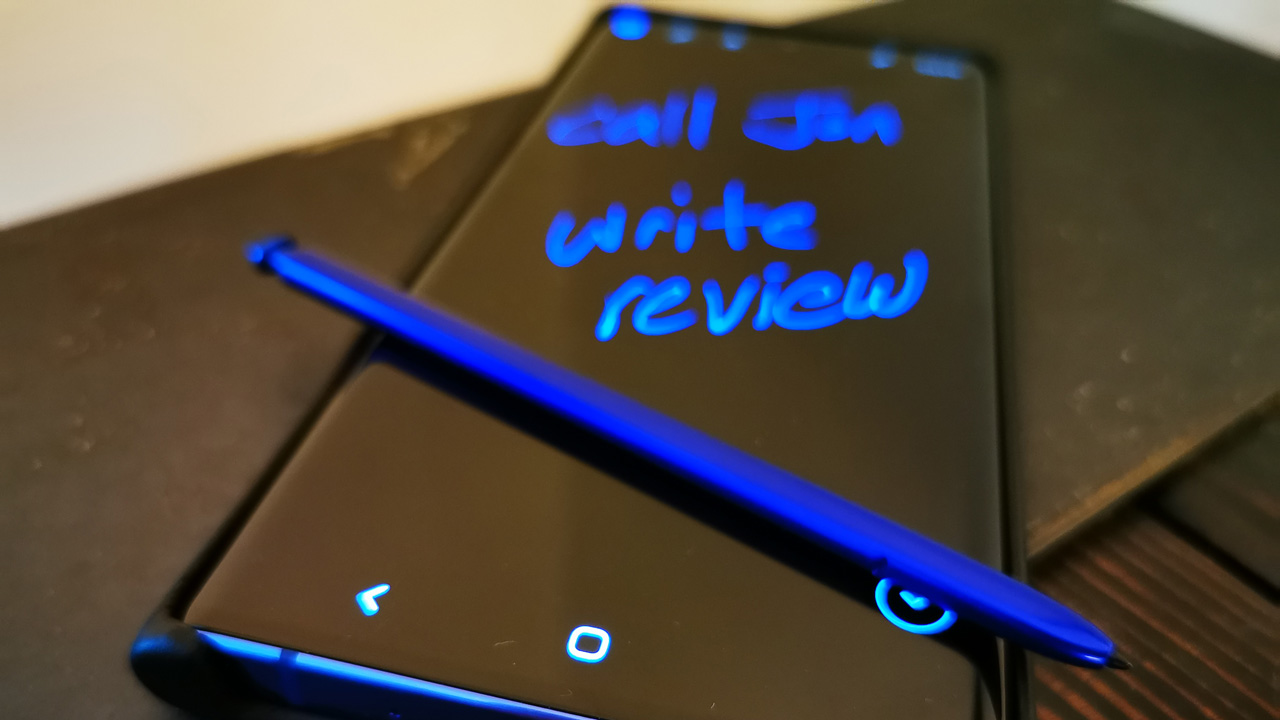
Last year, Samsung added a niche but useful non-writing/drawing feature to the S Pen by allowing users to click its top (eraser-like) button as a remote camera shutter. This is useful for timed group photos, I guess, though you’ll need to prop the device up somewhere first. It’s not something I’d ever use, but I see the value and appreciate the thought that went behind it.
This year, however, things get a bit sillier, with Samsung adding “air action” support to the S Pen, which has been designed to support motion control courtesy of a tiny accelerometer. What this means is that you can wiggle the S Pen in the air above the phone and have that movement trigger actions on-screen. And it’s as dumb as it sounds: You can use S Pen to swipe the air to move between pictures in Gallery, for example. Or swipe up and down while in the Camera app to switch between camera modes. Ugh.
The issue, of course, is that most of this works imprecisely, and in testing it, I found myself swiping the air like an idiot while nothing happened on screen. It’s a gimmick, and I’ve given up on it, as I suspect most Note 10 owners will.
Finally, we need to address the headphone jack. There isn’t one, and there’s no excuse for such an omission on a flagship smartphone. Worse, Samsung is rightfully dinged for not even including a USB-C headphone dongle, something that one might expect when paying $1100 or more for this handset.

Software
Samsung came under fire for its horrible Android skins of the past, but its latest user interface, called One UI, is quite attractive, and I like its squircle-shaped app icons better than those used by stock Android or any other Android skin I’ve used. The entire presentation is attractive, colorful, and professional-looking. And it is, for the most part, quite usable as well.

Samsung is also somewhat infamous for duplicating far too many built-in Android apps with its own versions, and you do see some of that here: There are Google calendar, clock, contacts, phone, messaging, notes, and picture gallery apps, among others, most of which are non-problematic. (And, yes, I’ve continued using the Samsung Messages app; it works just fine)

But things get a little weirder after that, with Samsung also offering its own app store (Samsung Gallery), electronic payment system (Samsung Pay), web browser (Samsung Internet), health and fitness tracker (Samsung Health), personal digital assistant (Bixby), and smart home interface (Smart Things). And it’s hard to escape the feeling that we’re just pawns in Samsung’s ongoing efforts to displace Google as much as possible and create its own pervasive Galaxy ecosystem in its place.
Don’t get me wrong, none of those things are truly horrible, not even Bixby. But many feel superfluous, and they add unnecessary complexity and choice to a platform (Android) that is already brimming with both.
The Note 10+, like previous Notes, also includes Samsung’s unique Edge panels, which can appear when you swipe in from the curved right edge of the display. The firm supplies several stock Edge panels from which to choose, like Apps, Live messages, People, and Weather, and I suspect that many find this to be a truly useful way to quickly access something they use a lot. But it’s superfluous, and often hard to access, and I just turned it off over time.
Overall, I do like Samsung’s One UI, a lot, but I find myself increasingly irritated by a few issues.
The biggest one, of course, is Bixby Home, which replaces the Google Discovery feed to the left of the first home screen. I don’t mind that Bixby Home exists; I mind that it’s not optional and can’t be replaced with the native Android feature.
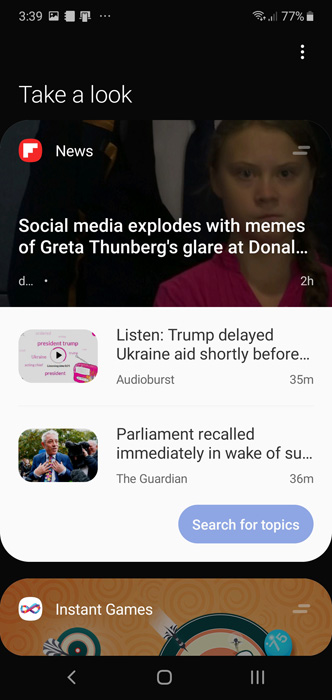
But it’s not just that. The more I use One UI, the more I run into things, little things that really add up in a negative way.
Take the Samsung keyboard, please: Sure, it’s a got a different layout than the Google Gboard keyboard that I’m used to, but I can adapt. And I did, at first, dealing with the misplaced microphone icon that I use to transcribe my voice so often. But that voice transcription is comically bad, and after a while, I just couldn’t take it anymore. So I installed Gboard and voila! Not only was the familiar layout back but now voice transcription works accurately again.
I also like to use icon notification dots so that there’s a visual cue when an app has alerted me to a new email, a new chat, or whatever. In stock Android, you can long-press on those icons and see what’s new in a pop-up menu. But Samsung overwrites this pop-up menu with its own user interface—which includes a non-standard way to remove the app from the home screen or uninstall it—and it does not let you see what’s new. So the notification dots are, if not useless, certainly less usable. I have to go in and out of the apps like its 2007 again.
The All Apps interface is also goofy. I like that you can swipe up on the home screen to access this interface more easily than even in stock Android. But All Apps is a multi-screen experience, and it scrolls horizontally. So you can swipe up from the first home screen and land in the third (or whatever) All Apps screen because that’s where you were the last time you visited; the switch between horizontal and vertical scrolling is jarring and requires real thought. I’m surprised you can’t configure this to work differently.
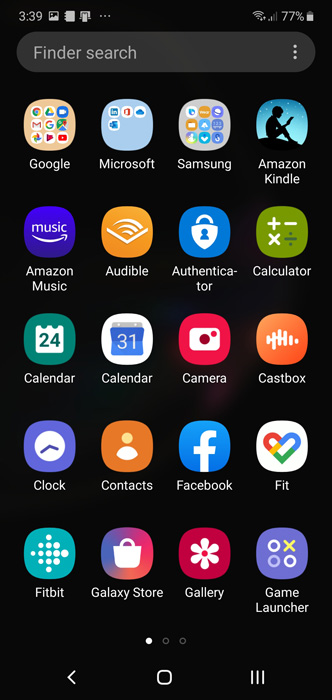
Then, there’s navigation. As you may know, Google moved to virtual navigation buttons years ago, and two years ago it began the push to gestural navigation with a nice two-button virtual navigation system, and this year Android (10) went fully gestural, which was even better. One UI is currently based on Android 9, but it still provides an old-fashioned three-button virtual navigation scheme—with the Back and Recents buttons reversed, like driving in the UK, for some reason. Worse, you can’t swipe in any way to access recent apps; you have to press the Recent button like it’s the 20th century again.
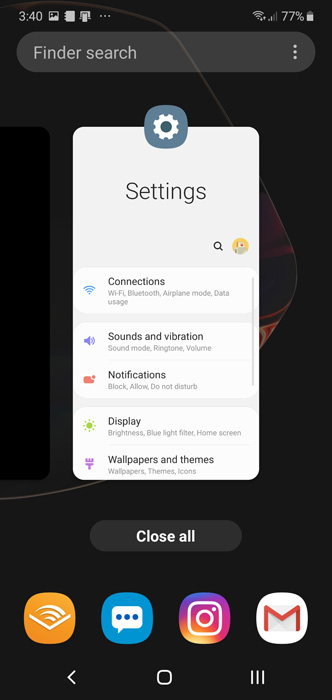
Samsung does let you reverse the Back and Recents buttons, of course. And it does offer a gestural navigation system, albeit one of its own invention. And it works nothing like other systems. Instead, you have to swipe up from the bottom of the screen in the location where the navigation buttons would be. So to go back, you swipe up on the left bottom of the screen, an unnatural gesture. Come on, Samsung: Just offer the normal Android options, too.
Finally, there’s DeX, Samsung’s desktop environment. I’ve found the performance of DeX to lag, both directly and via the PC app, making it less useful than it could be. I will continue testing this feature because I feel that Samsung might be on to something here—with the caveat that this kind of thing should come from Google, the platform maker—and that a large percentage of the population could benefit from its ability to take advantage of a larger display, a keyboard and mouse, and other peripherals.
Pricing and availability
The Samsung Galaxy Note 10+ sits at the apex of Samsung’s handset lineup and is priced accordingly. A “base” Note 10+ with 256 GB of RAM retails for $1100. That’s an astonishing sum, of course, but it’s also $150 less expensive than a similarly-configured Apple iPhone 11 Pro Max, which costs $1250 (and has non-upgradable storage). If you configure a Note 10+ with 512 GB of storage, the retail price is $1200.
The good news? Samsung’s handsets are often on sale and, as many know, the price seems to decline steadily over time. Plus, if you buy direct from Samsung or select retailers like Microsoft, you’ll get a higher-than-usual amount on trade-in, especially for newer phones. I received $600 for my Google Pixel 3 XL on trade, so my Note 10+ effectively cost just $500. (OK, not really. But you know what I mean.) There is no reason to pay full price for this or any other Samsung handset.
Recommendations and conclusions
As I used this handset over the past three weeks, my mind kept returning to the OnePlus 7 Pro, another incredible flagship handset with terrific specs, a large and gorgeous display, and many unique hardware and software features. The Note 10+ and the OnePlus 7 Pro have a lot in common, frankly. But each fails in a single important category where the other excels.
For Samsung, it’s the price: The OnePlus 7 Pro starts at just $700 for a 256 GB configuration—fully $400 (!) less than a comparable Note 10+. (Again, this differential will shrink over time.)
For OnePlus, it’s the camera: While I can live with the Note 10+ and am, in fact, sometimes impressed by its quality, OnePlus 7 Pro picture quality is unacceptably bad.
Put simply, I’d pay extra to get the Note 10+, since my personal preferences for picture quality preclude me from using a OnePlus 7 Pro, no matter how good it may otherwise be. But your own needs and wants will dictate your decisions, and rightfully so.
So, where do I stand?
Personally, I prefer the camera systems in the Huawei Mate 20 Pro and P30 Pro, and in all of the Google Pixel phones, including the most recent Pixel 3, Pixel 3 XL, and Pixel 3a XL models. And only Google’s handsets are fully compatible with Google Fi, the wireless network I use and love. But the Note 10+ exceeds each of those devices in some ways, too. The display is in another league from anything Google has ever offered. One UI is much better, and more refined, than Huawei’s terrible EMUI. The Note 10+’s performance and reliability are excellent, as is the battery life. The S Pen is a unique differentiator for those who want it.
Overall, I recommend the Samsung Galaxy Note 10+ highly with the understanding that the price will come down and that there are better camera systems out there. But even those who care about camera quality will likely be surprised by the Note 10+, at least usually. For all its faults, most minor, the Note 10+ is still one of the very best smartphones available today.
At-a-glance
Flagship
- Gorgeous, large edge-to-edge display
- Stunning design with unique Aura Glow choice
- Excellent performance
- Excellent camera system
- Storage expansion
- S-Pen
- Excellent battery life
Bargain bin
- Expensive
- Terrible in-display fingerprint reader
- No headphone jack, no USB-C dongle
- Air gestures are a gimmick
- Bixby is a pointless exercise in corporate hubris
- Samsung disables useful Android features
- DeX performance issues
- Too many superfluous software apps, services, and features